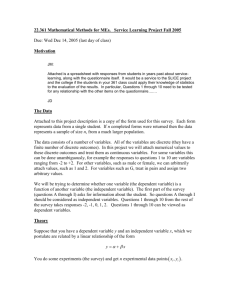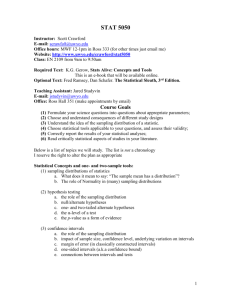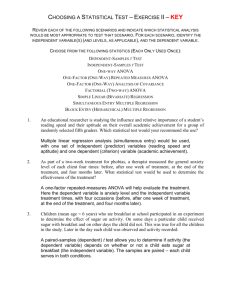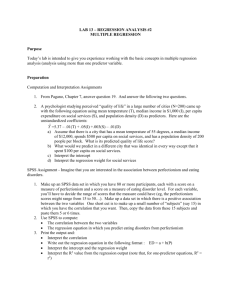Project: Forecasting Using Regression
advertisement
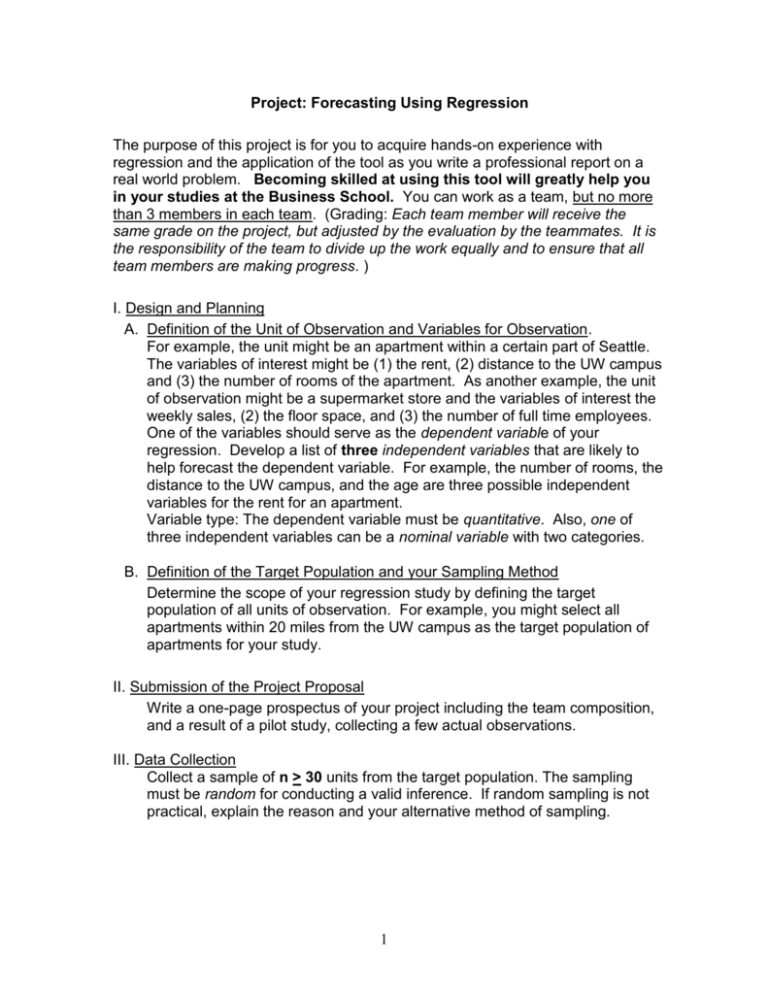
Project: Forecasting Using Regression The purpose of this project is for you to acquire hands-on experience with regression and the application of the tool as you write a professional report on a real world problem. Becoming skilled at using this tool will greatly help you in your studies at the Business School. You can work as a team, but no more than 3 members in each team. (Grading: Each team member will receive the same grade on the project, but adjusted by the evaluation by the teammates. It is the responsibility of the team to divide up the work equally and to ensure that all team members are making progress. ) I. Design and Planning A. Definition of the Unit of Observation and Variables for Observation. For example, the unit might be an apartment within a certain part of Seattle. The variables of interest might be (1) the rent, (2) distance to the UW campus and (3) the number of rooms of the apartment. As another example, the unit of observation might be a supermarket store and the variables of interest the weekly sales, (2) the floor space, and (3) the number of full time employees. One of the variables should serve as the dependent variable of your regression. Develop a list of three independent variables that are likely to help forecast the dependent variable. For example, the number of rooms, the distance to the UW campus, and the age are three possible independent variables for the rent for an apartment. Variable type: The dependent variable must be quantitative. Also, one of three independent variables can be a nominal variable with two categories. B. Definition of the Target Population and your Sampling Method Determine the scope of your regression study by defining the target population of all units of observation. For example, you might select all apartments within 20 miles from the UW campus as the target population of apartments for your study. II. Submission of the Project Proposal Write a one-page prospectus of your project including the team composition, and a result of a pilot study, collecting a few actual observations. III. Data Collection Collect a sample of n > 30 units from the target population. The sampling must be random for conducting a valid inference. If random sampling is not practical, explain the reason and your alternative method of sampling. 1 IV. Data Analysis Analyze the data collected, using the following steps: 1. Based on your prior knowledge or common sense, which independent variable do you think will be the best predictor of the dependent variable? Which variable is the second best predictor? The third best? 2. Apply appropriate statistical methods to identify the best, the second best and the third best predictors. Do the results agree with your a-priori reasoning? 3. For each independent variable, develop a simple regression to predict the dependent variable. Select the best regression. Please explain. 4. Construct a scatterplot of the residual vs. predicted value. Do you think that the error of the regression appear to have an equal variance? Please explain. V. Evaluation of Your Team Members Complete the form and submit separately. VI. Writing a Report Assume that you work for a company or work as a consultant for a client company that needs to have this data and write a report. The report should be no more than 4 pages (not including appendix), type-written, doublespaced, and font (arial) size of 12. Include in the main text only relevant computer outputs, e.g., scatterplots, regression outputs (excluding the analysis of the variance section), and so on. 1. Title Page Identification (name, student ID#, section) and the work performed by each team member ( 3), 2. Description of the problem a. Explain the background. Why does this project interest you? b. Definition of the study unit and the target population c. Definition of variables (1) The dependent variable for prediction (2) The list of three independent variables. d. Explanation of the sampling method 3. Regression analysis a. Scatterplot and correlation coefficient for each explanatory variable. b. Regression equation for each independent variable, including the standard error of estimate and R-squared. Which is the best predictor according to statistical analysis? State your reasoning. c. Result of testing the significance of the predictor for each regression. State P(Type I Error) = significance level. 2 d. The residual vs. predicted graph for the best predictor regression. Explain the implications. 4. Conclusions What are possible applications of the regression that you developed? 5. Appendix (not included in the page limit) Sources of the data used. Please submit a diskette that contains your data. Writing Help: A. Writing Center: One of the most important skills you should acquire as a manager is the ability to write a clear, concise report. Recognizing this need, the School has established a writing center, which offers individual tutoring for class writing assignments. The center is in 304 Lewis Hall. Be sure to sign up for a 30 minute appointment time on the sign-up sheet in the Advising Office, 137 MacKenzie, before the times you want are filled. B. Checklist for developing a professional report: The following checklist was developed by the Writing Center. Organization ____ Sections follow the specified sequence ____ Paragraphs are clearly organized - one point per paragraph ____ The conclusion gives a convincing argument for applications of your regression Presentation of Statistical Results ____ Numbers are presented at an appropriate level of detail ____ Graphs are proportioned to represent data accurately ____ The text clearly explains the numerical analysis Format ____ Presentation looks professional ____ Design and formatting features make the text easy to follow Editing and Mechanics ____ Grammar and punctuation are error free ____ Style is concise and to the point 3







